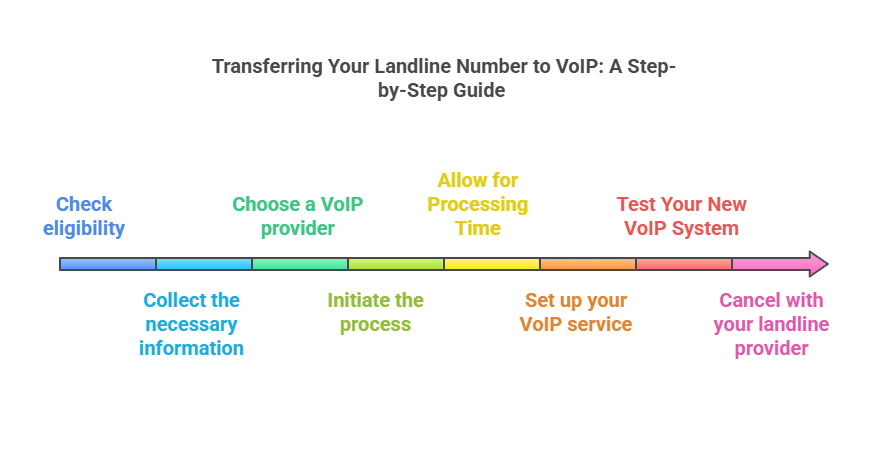When the idea of updating the traditional landline phone system to VoIP is proposed to a business, one of the major concerns they raise is whether the original phone number will still be usable after the upgrade. This concern is totally valid because potentially changing your phone number to a new one comes with the hassle of updating it across all your business profiles and customers. No business would want to lose its customer base and reputation built over time. Fortunately, you can keep using your old landline number by transferring it to the new VoIP system. The process is called porting, and it is not as complicated as it might sound. In this blog, we’ll discuss the step-by-step process through which you can transfer your landline number to VoIP, the time and cost involved, along with the answers to your common questions. By the end of this blog, you will have all the information you need to switch your landline number to VoIP successfully.
What is VoIP
Before moving further, let’s take a quick look at the definition of VoIP. The terminology ‘VoIP’ stands for voice over internet protocol, which allows you to make and receive calls on any device with an internet connection.
VoIP technology works differently from a landline phone system as it doesn’t require a physical route of cables from one end to the other. The calls are transmitted over the internet in 3 steps:
- When the call is made from one end of the connection, the analogue signals of the voice are converted into digital signals.
- Then, these digital signals are sent to the VoIP provider via the internet, where they get converted into IP packets. This conversion is done by codecs, which include compression and decompression algorithms.
- The final conversion from analogue to digital signals takes place at the receiver’s end, and a clear voice can be heard.
Compare VoIP Phone System Quotes Today
How to Transfer Your Landline Number to VoIP: Step-by-step process

1. Check if your number is transferable
Contact both your current landline provider and your future VoIP provider directly to confirm whether your number is transferable.
2. Collect the necessary information
Make sure you have all the important details about your landline phone system, like your account number, PIN, holder name, proof of connection like a phone bill, and the address associated with your connection. You’ll need this information when selecting a VoIP provider, so it’s best to have it beforehand.
3. Select a VoIP provider and start the process
Choose a reliable and experienced service provider whose pricing meets your budget requirements. After you’ve chosen a VoIP provider, submit a porting request through their portal to start the process. You will need to provide the information mentioned before in the required application.
4. Time required for the porting process
Porting your number can take anywhere from 8 days to a few weeks, depending on the providers involved. During this time, you can keep using your regular landline system.
5. Set up your VoIP service
While waiting for the porting process to complete, you can set up your VoIP account and devices in the meantime. You’ll find the instructions to configure your system from your VoIP provider, which makes it easy to install.
6. Test Your New VoIP System
Once the porting process is complete, test your VoIP system to make sure that your number is fully functional. Make a few test calls and verify that all features are working properly.
7. Cancel with your landline provider
After porting is fully complete and tested to be functional without any issues, you can go ahead and cancel your subscription with your landline provider.
Key factors to consider
Apart from the porting process, we have also discussed some important factors that you need to consider when switching from a landline phone system to a VoIP..
Internet connection
There are only two requirements to set up a basic VoIP system:
- A VoIP software subscription.
- An internet connection.
Your existing internet connection should be strong enough to support the operation of a VoIP system. Otherwise, you might need to update it as well.
Time consideration
The process of porting can take anywhere from 8 days – 4 weeks. This duration depends on a number of factors like the number of lines of your VoIP connection, the geographical area of connection, and the type of VoIP and landline providers you are working with. That’s why it is important to take a mental note of the time it’ll take for the whole process to complete. If you want to speed it up, contact your VoIP provider to see if they can accommodate your request.
Cost factor
The following factors influence the cost of transferring your landline phone number to VoIP:
- Your area of connection.
- Vary with each provider.
- Whether you are using cloud or hosted VoIP.
Some VoIP providers include number porting for free as part of their service package, while others charge a one-time fee or a recurring monthly fee to keep your ported number. On average, the one-time fee ranges from £10 to £30, while the monthly fee (if applicable) falls between £5 and £10. To get the best deal, compare quotes from multiple providers and choose the one that fits your budget.
Advantages of switching to a VoIP system

By switching your number from a landline to a VoIP, you will get access to various long-term benefits that will prove useful for your business operation in the long term.
Cost efficient
A VoIP phone system is cheaper than a landline in many ways.
- Doesn’t require a physical wired setup: A VoIP system only requires a good internet connection for its operation. It doesn’t require a hectic physical infrastructure, unlike a traditional landline system, for which you have to pay for a proper copper wire system.
- Lower per-user cost: A landline phone system costs around £14/user on average in the UK. However, a VoIP plan starts from as low as £7/user. This means almost a 50% cut in the overall cost.
- No requirement to buy new hardware: You can easily use VoIP on any device (laptop, tablet, smartphone, or a softphone). With a VoIP adaptor, you can even use your old landline desk phones for your VoIP system, so you might never need to purchase any additional hardware.
Portability
VoIP devices are highly portable; as long as you have an internet connection, you can take your VoIP device anywhere to make and receive calls. This is a perfect solution for remote teams to stay connected. VoIP also allows you to give shared numbers to multiple employees.
Ease of adding or removing phone lines
A VoIP system conveniently allows you to add or remove phone lines without making any major changes. On the other hand, if you wish to add or remove users in a landline system, you will have to install a new line for each user physically.
Advanced features
VoIP offers more than just calling, its special features make it a reliable option for businesses. One of them is called call transferring, which helps VoIP calls to be redirected to the relevant line among teams.
Apart from transferring calls, VoIP also allows video conferencing, screen sharing, call analytics, and integration with business systems. All these features greatly enhance teamwork, work efficiency, and communication in workplaces.
Get Started with VoIP Today with ComparedBusiness UK
ComparedBusiness UK streamlines the process of setting up a VoIP phone system for your business by connecting you with reliable VoIP providers in the UK. Just submit your requirements in under 2 minutes and we will get back to you with quotes from top VoIP providers.
FAQs
Yes, your landline service will remain active until the porting process is finalised.
Costs vary depending on the VoIP provider. Some providers offer free number porting as part of their plans, while others may charge a one-time fee (£10 to £30) or a monthly fee (£5 to £10).
Yes, you can use your existing landline phone with VoIP by using an Analog Telephone Adapter (ATA). This device connects your traditional phone to the internet.
